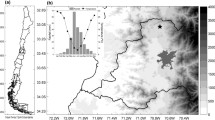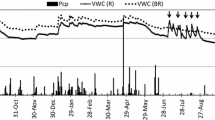Abstract
Plants play a key controlling role within the hydrological cycle. For analysing global change impacts on water resources in the Upper Danube basin, coupled and process-based modelling of vegetation water and carbon fluxes is needed. The model component Biological is part of the simulation system DANUBIA and calculates the processes of carbon assimilation and transpiration for various vegetation categories (e.g. grassland, winter wheat, sugar beet and maize). To best depict the complex interplay of water, carbon and nitrogen fluxes in agroecosystems, decisions on crop management are included in the modelling. Additionally, meteorological and pedological model input data are provided by other dynamically coupled DANUBIA model components. Modelling of photosynthesis and transpiration takes into account not only the predicted increases in air temperature and atmospheric CO2 concentration but also the availability of water and nitrogen. Maps of transpiration totals for one hydrological year are presented for several agricultural land uses in the Upper Danube basin. Local conditions, characteristics of the different vegetation categories and differences in management are shown. In this way, spatial and temporal changes in plant water demand and supply under global change conditions and altered cultivation practices are assessed at the regional scale.
Access this chapter
Tax calculation will be finalised at checkout
Purchases are for personal use only
Similar content being viewed by others
References
Bavarian State Ministry of Food, Agriculture and Forestry (ed) (1996) Bayerischer Agrarbericht, Munich
Farquhar GD, von Caemmerer S, Berry JA (1980) A biochemical model of photosynthetic CO2 assimilation in leaves of C3 species. Planta 149:78–90
KTBL Association for Technology and Structures in Agriculture (2000/01) Taschenbuch Landwirtschaft 2000/01, Landwirtschaftsverlag GmbH, Münster
Lenz VIS (2007) A process-based crop growth model for assessing Global Change effects on biomass production and water demand – a component of the integrative Global Change decision support system DANUBIA. PhD thesis, University of Cologne
Lenz-Wiedemann VIS, Klar CW, Schneider K (2010) Development and test of a crop growth model for application within a Global Change decision support system. Ecol Model 477:314–329
Yin X, van Laar H (2005) Crop systems dynamics. An ecophysiological simulation model for genotype-by-environment interactions. Academic Publishers, Wageningen
Author information
Authors and Affiliations
Corresponding author
Editor information
Editors and Affiliations
Rights and permissions
Copyright information
© 2016 Springer International Publishing Switzerland
About this chapter
Cite this chapter
Lenz-Wiedemann, V.I.S., Reichenau, T.G., Klar, C.W., Schneider, K. (2016). CO2 Fluxes and Transpiration. In: Mauser, W., Prasch, M. (eds) Regional Assessment of Global Change Impacts. Springer, Cham. https://doi.org/10.1007/978-3-319-16751-0_36
Download citation
DOI: https://doi.org/10.1007/978-3-319-16751-0_36
Publisher Name: Springer, Cham
Print ISBN: 978-3-319-16750-3
Online ISBN: 978-3-319-16751-0
eBook Packages: Earth and Environmental ScienceEarth and Environmental Science (R0)




